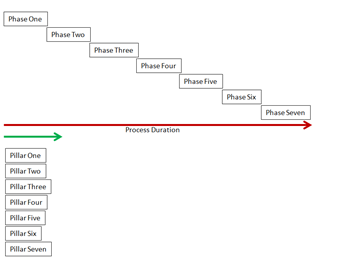Val Workman
The opinions expressed by the bloggers below and those providing comments are theirs alone, and do not necessarily reflect the opinions of Ryma Technology Solutions. As they say, you can't innovate without breaking a few eggs...
- Font size: Larger Smaller
- Hits: 28955
- 2 Comments
- Subscribe to this entry
- Bookmark
A closer look at the Seven Pillars of Collaborative Product Management
Recently, someone placed the following comment on one of my blog posts.
"The AIPMM Seven Phase Product Lifecycle Framework is a vendor independent Product Management and Product Marketing standard that takes into account best practices used in a wide range of companies and industries. ... The Framework includes seven distinct product phases, from Conceive to End of Life, and covers all aspects during the entire product lifecycle."
I'm familiar with the Seven Phase approach of the AIPMM, and it can work in some situations. I wanted to take a few minutes and help people understand the difference between frameworks like the Seven Phase Product Lifecycle Framework and the Seven Pillars of Collaborative Product Management.
First of all the intent was different. Frameworks like that of the AIPMM were developed to help organizations develop a product management practice. They provide much needed process guidance to the community, while allowing a certain amount of flexibility in specifically how you might achieve the objectives of the framework. The Seven Pillars of Collaborative Product Management was designed to be process agnostic. The Pillars categorize product management activities, not in terms of process sequence or dataflow, but in terms of business goals, objectives, strategies, and methods.

The frameworks provide a process template, the Pillars create a knowledge management system. This knowledge management system provides governance for whatever process sequence you chose. Because it's a knowledge management system, it maintains the integrity of information flow, while providing support to many different frameworks such as the AIPMM, Pragmatic, and CMMI. It also supports methodologies such as various agile, spiral gated, lean, and Sales-Design-Build (SDB), along with practices such as value engineering, Six Sigma, and creative problem solving. Because of the separation between dataflow and process flow, the Pillars provides support for the extremely competitive practices such as those found in the telecom industry where the time it takes to go from market evidence to product launch is measured in weeks.
Concurrent processing is the key, with team members continuously performing specific activities within one or two pillars. Management and execution of these activities happens at the speed of information.
Knowledge management systems are quickly superseding process frameworks as architectural structures within the product management community. Part of their success is that they can still support older frameworks, while delivering additional capability to organizations ready to leverage information pools and separate dataflow from process flow.










Today, according to the Tax Free World Association, annual duty-free sales are about $US25 billion ($28 billion).